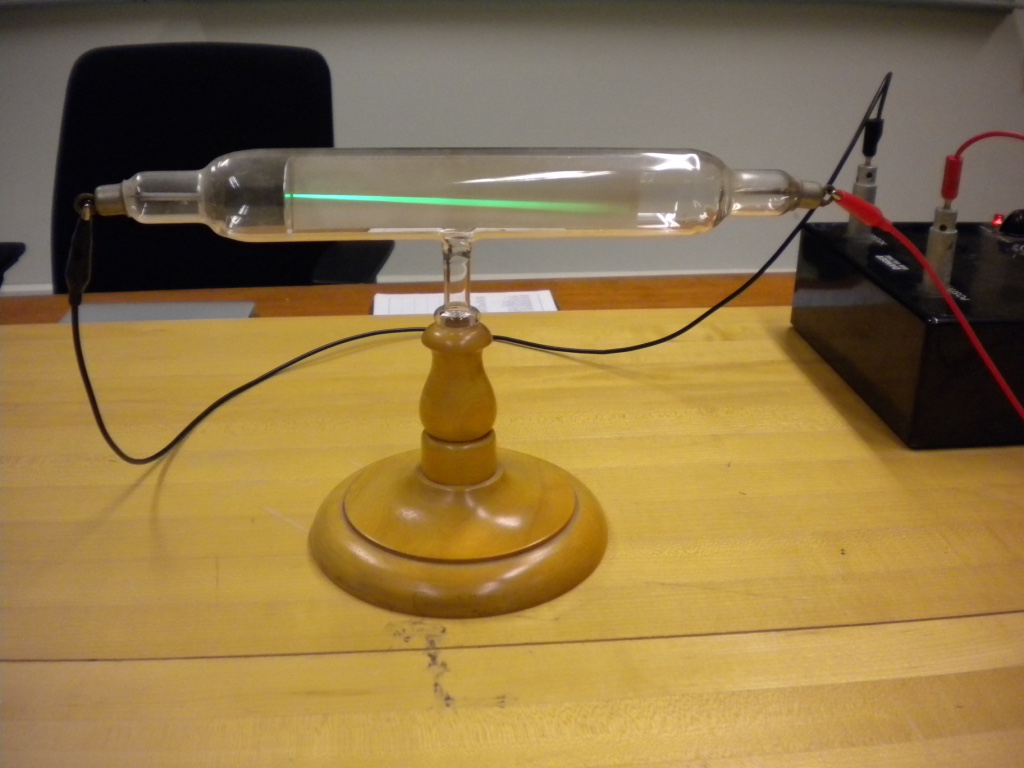
The second primary cause of error is the inaccuracy in the velocities of the electrons, as they will not have constant velocities, because the accelerating voltage does not generate a perfect field, and has to have a hole in the center for the electrons to pass through, meaning that they cannot be accelerated to the velocity given by the relationship between their kinetic energy and the electric potential energy that accelerates them as we use to calculate their energy. The only correction of this error would be to use the power supplies at levels that are dangerously high for the equipment, but doing so could further damage the equipment. The first cause of systematic error was the inaccuracy of measurement due to the curvature of the glass and the resulting parallax error, which is designed to be corrected by the parallax scale mounted in the back of the apparatus, but as that requires the alignment of the beam and its reflection, it is inaccurate, because the beam was so faint that it was extremely hard to find the reflection. This experiment had a great deal of systematic error involved with it's application.
#Cathode ray tube experiment equation for voltage manual
My answers for the questions posed in the lab manual are also found in my analysis notes. I found that the electron beam bent towards whichever plate was positively charged, which is what would be expected as opposite charges attract, such that in an electric field, a negative charge moves in the direction opposite the field lines and towards the positive pole. The other qualitative result that we were asked to find was the effect of using an electric field instead of a magnetic field to deflect the beam. The qualitative portion of the lab showed that rotating the bulb changed the path of the electrons, because in a magnetic field, the negatively charged electrons will feel a force relative to their velocity and if their velocity is not perpendicular to the field, the parallel portion of their velocity will not be acted upon, causing them to spiral. Because my answer's error does not include the true value within 10 standard deviations, it is reasonable to assume there is a large systematic error that caused my answer to be so high, which I will address in the next section. A direct comparison showed that my result is exactly twice the true value of the charge-to-mass ratio of the electron, and that the true value does not lie within 10 standard deviations of the mean for my answer. Having done so, I was able to compare my value with its error to the known value of 1.76*10^11. With these calculations the my final result was the average with the error being the summation in quadrature of the errors. The three results were found from the three methods that it requested for us to use to calculate the value of e/m, being the direct calculation, the calculation based off the regression line for constant voltage, and the calculation based off the regression line for constant current. This result was obtained from the three individual results which can be found in my analysis notes here. The results from these are discussed in the next section.ĭoing the calculations, my final result was that: The other qualitative experiment was using an electric field instead of a magnetic field to deflect the beam. I also took qualitative data with the formation of a spiral due to the presence of a velocity component parallel to the coils, formed by rotating the deflection tube. My accuracy will be discussed in the next section. This data I used to find three ratios and by averaging them, I was able to get what I hope to be an accurate answer for the e/m ratio. With the raw data that I measured in lab, I calculated the ratio e/m and generated graphs of the radius and current-inverse at constant voltage and of the radius-squared and voltage at constant current. For measurements taken on the second day of lab, I had to estimate the location of the radius as accurately as I could. I was only able to see the beam brightly enough to measure such the first day of my lab. To take the measurements, I set the current and voltage and allowed them to settle, then after recording them, I looked at the path of the electron beam and found the overlay between the beam and its reflection on the metal ruler in the back. My raw data is found in the first portion of my lab notebook which is linked above.

Thompson in 1897 when he first measured the charge to mass ratio of an electron using a cathode ray tube. This is similar to the experiment by J.J. For the weeks of October 27 and November 3, I chose to do the e/m ratio lab, in which I was using a setup involving helmholtz coils and an electron deflection tube to observe the path of an electron beam as it passes through a magnetic field and is bent into a circular path by the magnetic field.


 0 kommentar(er)
0 kommentar(er)
